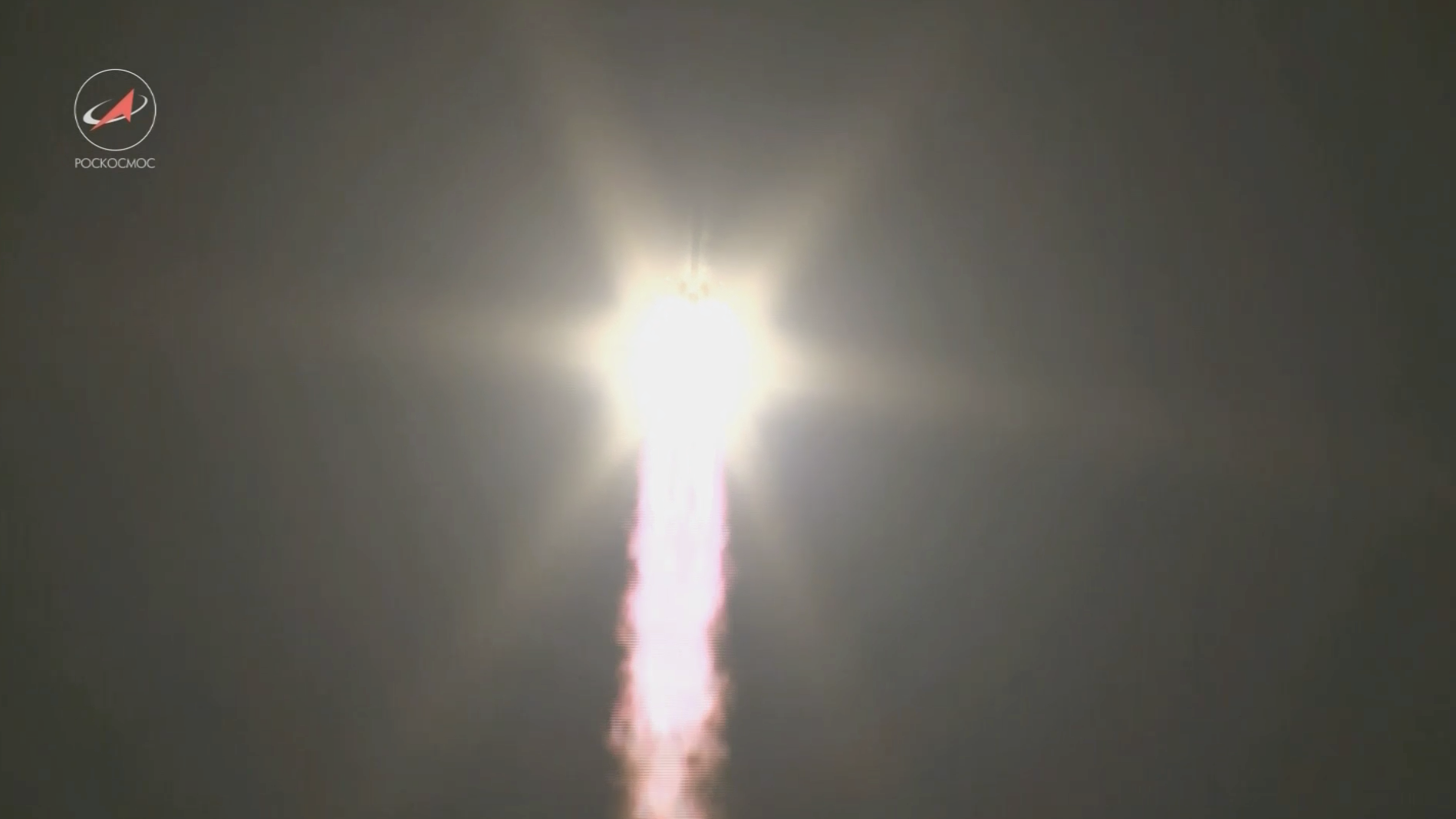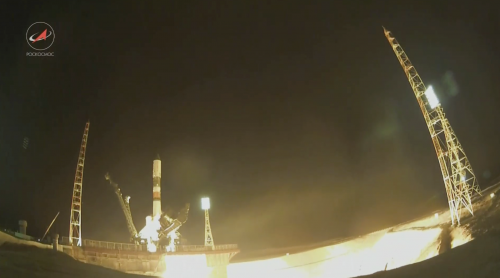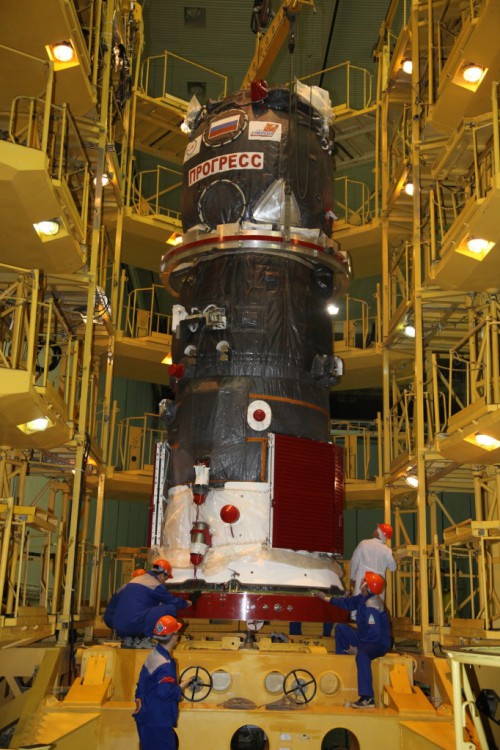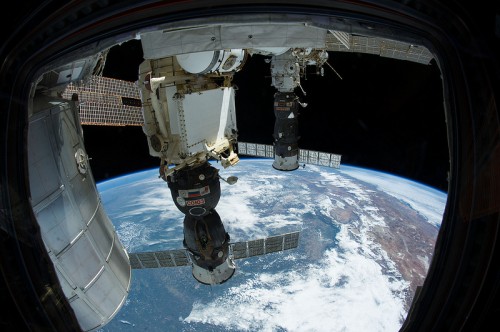
Russia’s Progress M-23M spacecraft has turned night into day across the Baikonur Cosmodrome, rocketing away from the central Kazakhstan launch site on a six-hour expedited journey to the International Space Station (ISS). Laden with about 5,250 pounds (2,380 kg) of cargo, including foodstuffs, water, propellant, equipment, and supplies for the station’s incumbent Expedition 39 crew, the Soyuz-U booster lifted off precisely on time at 9:26 p.m. local time (11:26 a.m. EDT) Wednesday, 9 April. Shortly after orbital insertion, the Progress spacecraft successfully separated from the third and final stage of the launch vehicle and was in the process of deploying its electricity-generating solar arrays and communications and navigation antennas, ahead of a textbook docking at the Earth-facing (or “nadir”) port of the Zvezda module at 5:14 p.m. EDT.
As described in AmericaSpace’s Progress M-23M preview article, this launch comes just two days after the departure from the Zvezda nadir port of its predecessor, Progress M-22M, which is now undertaking a series of autonomous experiments and maneuvers before it is deorbited on 18 April. The new Progress was fueled in the Spacecraft Assembly and Testing Facility at Baikonur last week and encapsulated within the payload shroud of its giant Soyuz-U booster last Thursday. Following technical management meetings and the Russian Government Commission, authorization was granted to transfer the stack out to the Site 1/5 launch complex. Early on Monday, 7 April, the Soyuz-U—a direct descendent of Chief Designer Sergei Korolev’s R-7 missile, with a heritage which extends back over five decades—and its precious cargo were rolled horizontally out to the pad and raised to a vertical configuration shortly after local sunrise.
Electrical and propellant umbilicals were connected as technicians prepared for the process of battery charging and fueling operations. Countdown activities began about eight hours before launch, and shortly before 6 p.m. local time (8:00 a.m. EDT) the State Commission issued a unanimous “Go” to begin transferring more than 595,250 pounds (270,000 kg) of rocket-grade kerosene (known as “RP-1”) and liquid oxygen aboard the booster. The lengthy fueling procedure was completed about two hours ahead of the planned launch time and entered a topping mode, whereby all cryogenic boil-off of propellants was rapidly replenished. This ensured that the liquid oxygen tanks were maintained at Flight Ready levels, ahead of the ignition of the Soyuz-U’s single RD-118 first-stage engine and the RD-117 engines of its four tapering strap-on boosters. Internal avionics were initiated and the on-board flight recorders were spooled-up to monitor the vehicle’s myriad systems. At about 8:40 p.m. local time (10:40 a.m. EDT), the main service gantry was retracted from the vehicle.

With a shroud of darkness cloaking Baikonur, all systems appeared satisfactory to support Russia’s second Progress launch of 2014. Two minutes before liftoff, the process of nitrogen purging of the engines’ combustion chambers got underway and the vehicle systems transitioned to internal power. At T-12 seconds the final launch pad umbilicals were disconnected from the Soyuz-U, and, two seconds later, the turbopumps on the core stage and strap-on boosters came to life. Following confirmation that the engines were running at full power, Progress M-23M roared into the darkened sky at 9:26:00 p.m. local time (11:26 a.m. EDT), turning night into day across the desolate steppe of Kazakhstan.
Rising rapidly, the vehicle exceeded 1,100 mph (1,770 km/h) within a minute of liftoff, during which time the maximum amount of aerodynamic stress (known as “Max Q”) impacted the vehicle’s airframe. At T+118 seconds, at an altitude of about 28 miles (45 km), the four strap-on boosters exhausted their liquid oxygen and RP-1 propellants and were jettisoned, concluding the phase of first-stage flight. This left the Soyuz-U’s central core and its single engine to continue the next stage of ascent. By two minutes into the flight, the rocket was traveling at over 3,350 mph (5,390 km/h). The payload shroud was jettisoned shortly afterward, and, at T+4 minutes and 45 seconds, the core stage separated at an altitude of 105 miles (170 km) and the RD-0110 engine of the third stage of the rocket was ignited to boost Progress M-23M to a velocity in excess of 13,420 mph (21,600 km/h).
By the point of third stage separation, at about nine minutes into the flight, the vehicle was officially in space. Separation of Progress M-23M from the final stage of the launch vehicle took place into a target orbit of approximately 120 x 152 miles (193 x 245 km), inclined 51.66 degrees to the equator. Shortly afterward, the process of unfurling its solar arrays and Kurs (“Course”) rendezvous and navigation appendages got underway. The spacecraft performed two computer-commanded “burns” of its maneuvering thrusters during its first, 90-minute orbit, followed by another two burns on its second circuit of Earth. These provided the proper conditions to rendezvous with the ISS.

Docking with the nadir port of the Zvezda module was expected to occur at about 5:20 p.m. EDT, a little less than six hours after launch. By 4:50 p.m., Progress M-23M was at a distance of less than 2,600 feet (800 meters) from the station. Shortly afterwards, it was commanded to hold its position, as mission managers conducted final checks, then executed a picture-perfect final approach. Closing at a rate of 1.6 feet per second (0.5 meters per second), the spacecraft’s velocity was subsequently reduced to just 0.3 feet per second (0.1 meters per second). Contact and capture was accomplished at 5:14 p.m., about six minutes ahead of schedule.
When pressurization and other checks have been confirmed, the Expedition 39 crew—commanded by Japan Aerospace Exploration Agency (JAXA) astronaut Koichi Wakata, the first of his countrymen in history to lead a space mission—will be able to access Progress M-23M on Thursday and begin unloading about 5,250 pounds (2,380 kg) of supplies. According to Spaceflight101, the cargo ship’s payload consists of 1,540 pounds (700 kg) of propellant, 925 pounds (420 kg) of water, 60 pounds (28 kg) of pressurized oxygen and air, and 2,680 pounds (1,215 kg) of dry cargo, the latter of which includes fresh food, such as fruit and vegetables, sanitary items, medical equipment, clothing, cleaning supplies, and replacement equipment and experiments. Also aboard Progress M-23M is 290 pounds (132 kg) of U.S. cargo.
The ISS is currently staffed by Wakata, together with Russian cosmonauts Mikhail Tyurin, Aleksandr Skvortsov, and Oleg Artemyev and U.S. astronauts Rick Mastracchio and Steve Swanson. Of these six men, Wakata, Tyurin, and Mastracchio have been in orbit since early November 2013, whilst Skvortsov, Artemyev, and Swanson arrived two weeks ago aboard Soyuz TMA-12M. Tonight’s arrival of Progress M-23M marks the first unpiloted visiting vehicle of Expedition 39, which began last month when outgoing Expedition 38 skipper Oleg Kotov handed command of the space station over to Koichi Wakata. The traffic of U.S. visiting vehicles is becoming somewhat congested, particularly in the aftermath of delays to the launch of SpaceX’s third dedicated Dragon cargo mission (SpX-3), which has been postponed until no earlier than Monday, 14 April. Since Dragon will remain berthed at the nadir port of the station’s Harmony node for about a month, the launch of the next visiting vehicle—Orbital Sciences Corp.’s ORB-2 Cygnus cargo mission—will likely be postponed by at least a week beyond its original 6 May target date.
With the arrival of Progress M-23M at the ISS, no fewer than two Progresses will be in attendance at the multi-national laboratory. Another craft, Progress M-21M, was launched in November 2013 and is presently docked at the aft longitudinal port of the Zvezda module, from which it executed periodic reboosts of the space station’s orbital altitude in December and March. It is scheduled to undock from Zvezda on 23 April for autonomous testing of the new Kurs-NA navigation system, before redocking two days later. Progress M-21M will then remain docked until mid-June, whereupon it will depart the ISS for the final time and be deorbited in the upper atmosphere.

Progress has a storied history. Its development began in 1973 in response to the anticipated problem of resupplying and refueling the Soviet Union’s Salyut 6 space station, whose cosmonauts went on to spend more than six months at a time in orbit. Modeled closely on the Soyuz spacecraft, its interior was redesigned to house foodstuffs, water, experiments, and fuel for the station’s maneuvering thrusters. Since its maiden voyage, Progress has seen many changes, but its role has remained largely unchanged … and the numbers speak for themselves. Between its first launch in January 1978 and today’s flight, no fewer than 144 Progresses have roared aloft. Only one has failed to reach its destination: the unlucky Progress M-12M in August 2011, whose launch vehicle suffered an engine malfunction and re-entered the atmosphere over the Altai region.
Writing in 1998, astronaut Jerry Linenger—one of the handful of U.S. astronauts to reside aboard Russia’s Mir space station—recounted the sheer joy of receiving a shoebox full of goodies from his wife and children: “Once found, and munching on fresh apples that had also arrived in the Progress,” he described in his memoir, Off the Planet, “we individually retreated from our work and sneaked off to private sections of the space station, eager to peruse the box’s contents.” Fellow astronaut John Blaha once described similar excitement: “Once we found our packages,” he wrote, “it was like Christmas and your birthday, all rolled together, when you are five years old. We really had a lot of fun reading mail, laughing, opening presents, eating fresh tomatoes and cheese.” In more recent times, ISS crew members have done much the same. In February 2008, Peggy Whitson, commander of Expedition 16, remembered crewmate Dan Tani calling one Progress “the onion express,” as the latest delivery of letters from home and fresh foodstuffs arrived.
In their book Soyuz: A Universal Spacecraft, David Shayler and the late Rex Hall speculated that the term “Progress” may have originated from the implication of having made significant progress in space station operations, although the precise heritage of the name remains unclear. What is clear, though, is that aside from the technical and functional role of Progress over the decades, it has provided an indispensable psychological crutch for dozens of cosmonauts and astronauts—a crutch which has enabled them to overcome the profound isolation of the strange microgravity environment, far from family and friends.
Want to keep up-to-date with all things space? Be sure to “Like” AmericaSpace on Facebook and follow us on Twitter: @AmericaSpace
Missions » Progress » M-23M »


